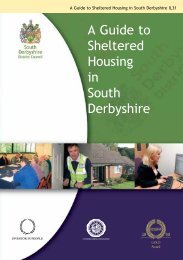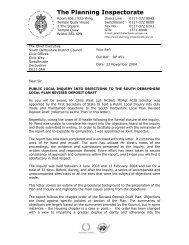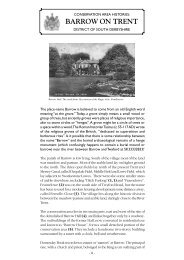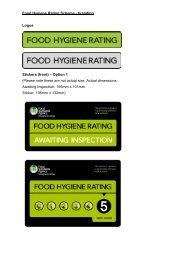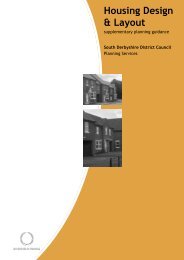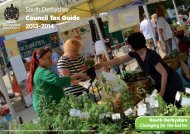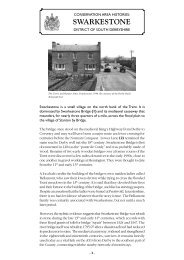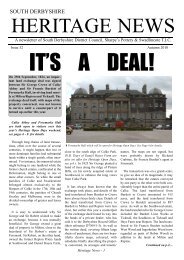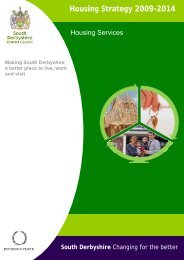Swadlincote History Trail - South Derbyshire District Council
Swadlincote History Trail - South Derbyshire District Council
Swadlincote History Trail - South Derbyshire District Council
Create successful ePaper yourself
Turn your PDF publications into a flip-book with our unique Google optimized e-Paper software.
<strong>Swadlincote</strong> <strong>History</strong> <strong>Trail</strong>: <strong>History</strong> Notes<br />
<strong>Swadlincote</strong> – A Potted <strong>History</strong><br />
In the Domesday Book of 1086, <strong>Swadlincote</strong> is recorded as just a small village in the more<br />
important parish of Church Gresley. Now, however, <strong>Swadlincote</strong> is <strong>South</strong> <strong>Derbyshire</strong>’s largest<br />
town. The population at the beginning of the 21 st century was around 30,000 people.<br />
The use of the word ‘town’ is, perhaps, misleading. <strong>Swadlincote</strong> is made up of three separate<br />
settlements – <strong>Swadlincote</strong>, Church Gresley and Newhall. These combine with the parishes of<br />
Woodville and Castle Gresley to form a band of development across the southern part of the<br />
<strong>District</strong> – lying between Burton on Trent in the west and Ashby de la Zouch in the east.<br />
The earliest written reference to the town’s mineral deposits is found in a document dated<br />
1294. This recorded the granting of mineral extraction rights. However, throughout the<br />
Middle Ages, although some coalmining and pottery-making was carried out, the area<br />
remained essentially rural. The real growth of <strong>Swadlincote</strong> took place after the late 18 th<br />
century with the development of coal and clay extraction on a commercial basis. This was a<br />
result of the demand for coal and clay during the Industrial Revolution.<br />
Throughout the 19 th century, a number of collieries, brickworks and potteries were<br />
established – including Sharpe’s Pottery in 1821. The large variety of clays present in the coal<br />
deposits of the <strong>South</strong> <strong>Derbyshire</strong> coalfield enabled a wide range of products to be made,<br />
including salt-glazed sanitary pipes, sanitary ware, bricks, tiles, chimney pots, firebricks and<br />
domestic articles. As this industry grew so did the number of chimneys and kilns. It was<br />
possible to see 60-70 chimneys from almost anywhere in the town.<br />
The growth of coalmining and the clay industry continued until just after the Second World<br />
War. With it came an increase in population and the building of many new houses. Related<br />
industries such as boilermaking and engineering and shopping facilities expanded to serve the<br />
growing population. All this expansion was achieved at considerable cost to the environment.<br />
The town suffered a shortage of stable building land and became scarred by colliery spoil<br />
heaps and clay holes.<br />
Today, the approach is one of trying to balance the need for mineral extraction with the need<br />
to protect the environment and provide amenities for the local community. All of the old<br />
colliery spoil heaps and clay holes have now been landscaped with trees and grass. The last<br />
colliery closed in 1988. As far as clay is concerned, the making of stoneware pipes continues.<br />
The engineering industry also remains important.<br />
<strong>Swadlincote</strong> now is in the heart of The National Forest. The National Forest is transforming<br />
200 square miles of town and countryside into the largest multi-purpose forest created for<br />
the nation in a thousand years. Planting has extended right into <strong>Swadlincote</strong> with the<br />
creation of <strong>Swadlincote</strong> Woodlands Forest Park. The area was formerly used for opencast and<br />
clay manufacture and extraction. The 80 acre site includes a network of forest trails and<br />
footpaths set amongst more than 22,000 trees.<br />
Within a relatively short period of time, <strong>Swadlincote</strong> has changed. It has evolved from a<br />
community whose development, wealth and way of life were closely related to the mining<br />
and pottery industry to a bright modern town which is now the administrative centre for the<br />
whole of <strong>South</strong> <strong>Derbyshire</strong>.<br />
The heritage remains, however, for those who look closely, and we hope you enjoy the brief<br />
introduction provided by this trail!<br />
Education Team, <strong>South</strong> <strong>Derbyshire</strong> Environmental Education Project.
These notes<br />
should be<br />
viewed<br />
alongside the<br />
<strong>History</strong> <strong>Trail</strong>,<br />
which has<br />
pictures to help<br />
you identify<br />
each building<br />
and directions<br />
around the<br />
town centre<br />
1. Razor like<br />
ceramic.<br />
2. You’ll need<br />
to co-operate<br />
to fill your<br />
house!<br />
3. Legal<br />
establishment<br />
still marked by<br />
brothers who<br />
sold flowers.<br />
4. Wesley’s<br />
method.<br />
Name / use of<br />
building<br />
Apr 04<br />
Sharpe's Pottery<br />
Centre<br />
Now Ward &<br />
Brewin Funeral<br />
Directors,<br />
YMCA furniture<br />
shop. and Auto<br />
Shop.<br />
Timms Solicitors<br />
Wesleyan Chapel<br />
<strong>History</strong> Notes:<br />
These notes are a compilation of interesting facts and<br />
figures about <strong>Swadlincote</strong>’s buildings and history.<br />
It is intended to be an introduction rather than a<br />
comprehensive guide, and you can find out more by<br />
visitng Sharpe’s Pottery and the various groups that meet<br />
or work there.<br />
You may know more about some of the buildings<br />
featured: if so please write and let us know (giving<br />
references if possible to back up any facts), so that we<br />
can update the notes to everyone’s benefit!<br />
Sharpe’s was a pottery, built in 1821 by Thomas Sharpe<br />
(died 1838). It was known first for the production of<br />
cheap “yellow ware” and later for the production of<br />
“sanitary ware”, such as toilets and wash basins etc. The<br />
factory exported world-wide.<br />
Edmund Sharpe developed the technology and patented a<br />
successful variation of the flushing WC rim in 1855. The<br />
pottery stopped production in 1967, and fell into<br />
disrepair, before being restored as a visitor centre and<br />
museum. It opened to the public in January 2003.<br />
Go inside and have a look around if you would like to<br />
know more!<br />
This building was built in 1915 by the Burton Co-operative<br />
Society. It stands on the site of the Sharpe’s second<br />
pottery, built in 1832 which was pulled down in 1907.<br />
The rounded corner of the building is built on the circular<br />
foundation line of one of the old bottle kilns.<br />
The Co-op had its own majestic style of building. The<br />
fronts were often very decorative, using big baked clay<br />
blocks called “faience” for the ornamental features.<br />
Behind the fronts, the buildings were usually plain and<br />
factory-like.<br />
The Co-Op has moved to The Delph.<br />
Used to be Davies Brothers Florists. The DB initials are<br />
still there below window.<br />
The site of this building used to be part of the Sharpe’s<br />
Pottery site. Sharpe’s sold it to Davies Bros. in 1921 for<br />
their new florists shop. The initials “DB” can still be seen<br />
at the bottom of the shop front, with an appropriate<br />
floral design on the tiles. It used to be common for shop<br />
owners to build their names into the architecture of a<br />
building. They probably expected to be there for a long<br />
time! Today, shops tend to change hands more quickly.<br />
Methodist or other “Nonconformist” churches were very<br />
important in industrial towns like <strong>Swadlincote</strong>. They<br />
believed that people should strive to improve themselves<br />
and help each other, and that simply going to church was<br />
not enough. It was a philosophy that appealed to the<br />
workers.
The Methodist Chapel is the oldest-established religious<br />
building in <strong>Swadlincote</strong>. It was originally built in 1816,<br />
enlarged later, and rebuilt in 1863. Methodist chapels<br />
are often called “Wesleyan” chapels after the brothers<br />
John (1703-1791) and Charles (1707-1788) Wesley, who<br />
led Methodism in its early days.<br />
5. Place of<br />
modern<br />
imperial flicks.<br />
6. A place that<br />
helps you see<br />
the nearby<br />
bear.<br />
7. Upmarket,<br />
Choice<br />
8. Where the<br />
nobles kept<br />
their salt?<br />
9. Timeless like<br />
a jewel.<br />
New Empire<br />
Arcade<br />
Grimley & Glynn<br />
(Opticians)<br />
Select<br />
(Clothes shop)<br />
Formerly Lloyd’s<br />
Bank<br />
Was CPL coal<br />
shop,<br />
Now Noble Tiles<br />
Dinnis<br />
(Jeweller/Clock<br />
repair)<br />
The original “Empire”, a cinema and theatre, opened on<br />
Boxing Day 1912. Not everyone approved of it. One<br />
protester said that the Devil had got his way now that<br />
there was a picture house so close to a chapel.<br />
The Empire was rebuilt and enlarged around 1930. Its site<br />
was originally part of the Sharpe’s Pottery premises. It<br />
was also used as a theatre for Gilbert & Sullivan<br />
‘Operettas’ etc<br />
The clue is a play on words!<br />
Grimley and Glynn Opticians, and all the shops attached<br />
on the south side of the Delph, were built in the 1960s. A<br />
handsome Victorian pub called the Nag’s Head was pulled<br />
down to make way for them.<br />
The fashion in the 1960s was for plain buildings built of<br />
modern materials, often with flat roofs. They were<br />
meant to be cheerful, and their deliberate contrast with<br />
older buildings was intended to point towards a brighter,<br />
modern future. However, they often lack the elegance<br />
and longevity of the older designs.<br />
The Optician’s is next to The Bear Pub.<br />
Look at the brickwork and the baked clay blocks on this<br />
building. You will see all sorts of “special” shapes in<br />
them. Some are like pieces in a jigsaw, that fit together<br />
to make a whole arch or a pattern. Others are specially<br />
shaped, to make elaborate horizontal bands across the<br />
building. The Victorians liked to experiment with<br />
decoration, sometimes even on ordinary houses, and a lot<br />
of these “special” bricks were made in and around<br />
<strong>Swadlincote</strong>.<br />
When the bank closed in 2000, the building was<br />
threatened with demolition due to safety fears.<br />
This shop was part of ‘Salts brothers’ business –they had<br />
several shops on the High Street, selling a range of goods.<br />
Salts had an ingenious system for moving money around<br />
their shops called the Lamson and Paragon Catapult.<br />
For many years the shop was then used as the Coal Shop,<br />
finally closing in 2002/3. One of the last reminders of the<br />
coal industry in S <strong>Derbyshire</strong>.<br />
This is one of the best period shop fronts in <strong>Swadlincote</strong>,<br />
built in the early 1900s. Note, for instance, the curved<br />
glass which is very expensive to replace.<br />
The Dinnis Family have owned the shop for 3 generations,<br />
moving here from their previous premises (also in High
10. What you<br />
get from<br />
valuable sheep?<br />
11. Where the<br />
son of Morris<br />
lives, but where<br />
pipes were once<br />
made.<br />
12. Where Art<br />
Harvey plied his<br />
many trades.<br />
13. Find the<br />
curtain mill<br />
where<br />
motorbikes used<br />
to park.<br />
14. Can you see<br />
the beer for the<br />
trees?<br />
15. Get your<br />
cards here, but<br />
don’t get toffee<br />
stuck to them!<br />
Woolworths<br />
Hepworths<br />
(Pipe works)<br />
A new<br />
supermarket and<br />
various other<br />
buildings/ shops<br />
are planned for<br />
this site…<br />
Motorbike shop<br />
on Hill St<br />
-formerly<br />
Parran’s solicitors<br />
John Mills<br />
(Curtains etc)<br />
Foresters Arms<br />
(Pub)<br />
Thornton’s<br />
St) early in the twentieth century. There have only been<br />
2 clocks in that time!<br />
The firm started out in <strong>Swadlincote</strong> in 1889 as a jeweller<br />
/ pawnbroker.<br />
Woolworths was founded in the UK in 1909, as part of a<br />
global expansion plan from it’s base in USA. The first<br />
shop in the UK was in Liverpool.<br />
Before <strong>Swadlincote</strong> was famous for making toilets and<br />
sewage pipes, it was already well-known for making heat<br />
resistant “fire-bricks” and cheap earthenware for<br />
kitchens and dairies. The tall chimney, built around 1910,<br />
was the main factory chimney of Wragg’s pipeworks,<br />
taken over by Hepworths in 1978. The chimney served<br />
the boilers and some of the kilns.<br />
The factory was started as a firebrick works in 1790 by a<br />
farmer called John Hunt. It was taken over in the 1840s<br />
by James Woodward and under the Woodwards ownership<br />
the works were greatly enlarged and rebuilt. Sewage<br />
pipes made by Woodwards and other local firms were<br />
exported all over the world. Cairo, Rio de Janeiro and<br />
Mexico City all stand on <strong>Swadlincote</strong> sewage pipes!<br />
Most of the old buildings on the Woodwards site were<br />
pulled down when the factory was modernised in the<br />
1960s and ‘70s. In the 1980s, there was an application to<br />
pull down the chimney, but it was saved after a Public<br />
Enquiry concluded that it was an important landscape<br />
feature, representing the industrial heritage of the area.<br />
The landscape around this chimney has changed beyond<br />
recognition!<br />
The land was sold to Morrison’s in 2002, with the<br />
condition that the chimney and the building adjoining it<br />
would be preserved in the new development.<br />
Has ‘Arthur Harvey’ sign on side giving his many trades<br />
such as plumber etc.<br />
Was a solicitor’s until 2000… a business which ended up<br />
in court.<br />
This used to be motorcycle shop called Parkes.<br />
The building is viewed as one of the gateways to the<br />
town centre. Again – note the style of the windows.<br />
Apparently, in 1931, the landlord of this pub was H. Bark!<br />
Interesting glass in windows upstairs.<br />
This used to be a hardware/ wool shop called<br />
Wroughtons.
16. Used to be<br />
the financial<br />
centre of the<br />
land.<br />
17. Where Stan<br />
hoped to get a<br />
beer but got<br />
clothes for<br />
Libby<br />
18. Home of<br />
travelling<br />
parrot?<br />
19. Place of<br />
animals, but in<br />
the past they<br />
wouldn’t have<br />
wanted to come<br />
here!<br />
20. Home of<br />
saintly charity<br />
21. Moving<br />
centre of trade.<br />
Open but not<br />
open.<br />
22. Look for<br />
where the<br />
avenger held<br />
court.<br />
23. Catch a<br />
train to<br />
Granville to<br />
quench your<br />
thirst.<br />
HSBC<br />
(Hong Kong &<br />
Shanghai Banking<br />
Corporation)<br />
Libbys<br />
(Clothes)<br />
Lunn Poly<br />
(Travel)<br />
‘Poly’ or Polly, is<br />
a nickname for a<br />
parrot<br />
Pet Shop<br />
St Giles Hospice<br />
Shop<br />
Indoor Market<br />
This covered<br />
market is open to<br />
public but not to<br />
the rain!<br />
Town Hall<br />
(Market Hall)<br />
Sir Nigel Gresley<br />
(Pub)<br />
This was the Midland Bank<br />
HSBC took over Midland Bank group in 1999<br />
You will notice that many of the buildings on the High<br />
Street use anti-pigeon tactics –but this one is the most<br />
dramatic. Do you think it works?<br />
This used to be Stanhope Arms Pub, and looks like it may<br />
have been an upmarket watering hole in its day!<br />
‘Stanhope’ was the surname of the landowning family<br />
that used to live at Bretby Hall.<br />
Thomas Cook, the famous Travel Agent founder who<br />
started out in NWLeics (inc Bath Yard, next to Conkers!),<br />
and was born in Melbourne.<br />
It was ‘Robert & Birch’ Butcher’s Shop, so animals<br />
wouldn’t like it then!<br />
This building is less than 100 yrs old, although it is built<br />
in the much older Tudor style. You can distinguish ‘mock’<br />
from real tudor partly by the size / height of floors and<br />
the shape, cut and ‘finish’ of the timbers and glass used.<br />
Genuine Tudor buildings have uneven glass panes, and a<br />
rough, uneven size and finish on the timbers as they were<br />
cut by ‘adze’ rather than machine. Room height was<br />
generally much lower in Tudor buildings.<br />
It used to be a Pharmacy called Scraggs.<br />
Look at the bracket high on the wall where the old<br />
chemist sign used to hang.<br />
There used to be large flasks of coloured fluid in window.<br />
The Market moved from The Delph to this covered hall.<br />
In 2000, some of the market traders moved back outside<br />
to The Delph.<br />
This building cost £1,179 to build. A ‘Petty crimes’ court<br />
was held every Tuesday under the clock.<br />
The Clock “Time the Avenger”, cost the princely sum of<br />
£44.<br />
This pub was “The Granville Arms”, Wetherspoons<br />
changed the name when they refurbished the pub in<br />
2001.<br />
The Granville’s were local landowners till 1872<br />
Sir Nigel Gresley was a railway engineer, famous for<br />
designing locomotion engines including ‘The Mallard’ &<br />
‘The Flying Scotsman’.
24. Linked<br />
buildings start<br />
with their own<br />
Club?<br />
25. Garden of<br />
two princesses<br />
and one grand<br />
house.<br />
Shoemart /<br />
Derbys Building<br />
Society row of<br />
shops.<br />
Grove Gardens<br />
This row of shops on Market Street marks the site of some<br />
of <strong>Swadlincote</strong>’s oldest houses, demolished long ago.<br />
More recently this was the site of <strong>Swadlincote</strong>’s open<br />
market, before the present row of shops was built in 1987<br />
Princess Anne opened the Grove Hall (behind this<br />
garden), which is part of the Leisure Centre, in 1981.<br />
Diana, Princess of Wales, visited in 1991. The Grove<br />
Gardens mark the site of a “clay hearth” where the<br />
Sharpe family used to store their clay, leaving it to<br />
weather down in the open air prior to use.<br />
“The Grove” was a large Georgian farmhouse where the<br />
Sharpe family lived since the 1820s or earlier,<br />
conveniently near their potteries. It was demolished in<br />
1972. All that is left is an old barn (now part of the<br />
Snooker Centre) and part of the garden wall, with trees<br />
behind it.<br />
These <strong>History</strong> notes have been compiled from information kindly provided by:<br />
Philip Heath, Heritage Officer, <strong>South</strong> <strong>Derbyshire</strong> <strong>District</strong> <strong>Council</strong><br />
Monica Hudson, <strong>South</strong> <strong>Derbyshire</strong> Writer’s Group<br />
Beryl Storer, local resident<br />
Other Sources:<br />
<strong>South</strong> <strong>Derbyshire</strong> Official Guide, published by The British Publishing Company, 1997<br />
James Woodward Limited, <strong>Swadlincote</strong> – A Study of the “Anchor Works” 1790 –1978, published<br />
and printed by <strong>South</strong> <strong>Derbyshire</strong> <strong>District</strong> <strong>Council</strong>, 2003<br />
<strong>Swadlincote</strong> Townscape Audit, published and printed by <strong>South</strong> <strong>Derbyshire</strong> <strong>District</strong> <strong>Council</strong>,<br />
2001<br />
If you can add to the notes, or if you would like to comment on the trail, please write to the<br />
Environmental Education Project, Unit 1a, Rosliston Forestry Centre, Burton Rd, <strong>Swadlincote</strong><br />
<strong>Derbyshire</strong> DE12 8JX.<br />
Please note: we intend to update the trail once a year.<br />
The Town <strong>Trail</strong>s have been created by <strong>South</strong><br />
<strong>Derbyshire</strong> Environmental Education Project,<br />
which is based at Rosliston Forestry Centre.<br />
Environmental Education is supported by:



